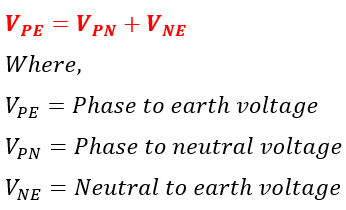You may have noticed that an AC circuit consists of three types of wires: Phase, neutral, and Earth. It is crucial to identify and understand the electrical phase, neutral, and earth wires in electrical circuits for installation and troubleshooting.
Incorrect electrical installations can be extremely dangerous for both electrical equipment and people. They can lead to electrical short circuits and electrocution. Connecting equipment to the phase and earth may function properly, but if a person touches the enclosures, they may receive an electric shock. Therefore, it is crucial to comprehend what phase, neutral, and earth are and how to use them correctly.
Phase, Neutral, and Earth Wires
Electrons flow from negative to positive potential, causing the current to flow from positive to negative potential. For an electric current to flow in a closed circuit, there must be a potential difference. In AC, the potential difference is caused by the difference in potential between the phase and neutral wires. The phase wire is at a higher potential than the neutral wire, which means that the current flows from the phase wire to load and returns through the neutral wire.
“Does all of the current from the phases flow back through the neutral wire? The answer is yes. It must flow back through the neutral wire. However, if the insulation system is poor, the leakage current can cause the neutral current to be slightly less than the phase current.” If you recall, the earth leakage circuit breaker is installed in a circuit to check whether the phase current and neutral current are equal. If there is any difference in the currents, it will trip the circuit.
If the current leakage flows through the enclosure, it can create voltage on its surface. Anyone who comes in contact with it might get an electric shock. The enclosure should be connected to an earth point to ensure safety in this scenario. This will bring it to zero potential and eliminate any risk of harm to people.
Thus, the load current flows through both the phase and the neutral wires, while the earth wire is responsible for carrying current in the event of an electrical fault. The earth wire serves as an electrical safety measure.

Let’s understand the procedure for checking the phase, neutral, and earth wires.
How to identify phase, neutral, and earth wires?
You can use a line tester to test whether a wire is a phase or neutral wire. Place one end of the tester on the connection point of the wire, and put your thumb on the metallic touch screw of the tester. If the neon bulb inside the tester glows, it indicates that the wire is the phase wire (live wire). However, if you test the neutral or earth wires, the tester will not glow. Therefore, it is not possible to identify the neutral and earth wires with a line tester.
To test the phase, you can use a test lamp. Connect one end of the test lamp to the neutral wire and the other end to the phase wire. If the bulb glows on connecting the other end of the test lamp, then the wire you connected it to is the phase wire. However, it’s important to note that you can not identify neutral and earth with this method, just like a line tester.
So, how do we identify the neutral and earth? You can easily identify phase, neutral, and earth with the help of a multimeter. The procedure for testing is given below.
- Connect a multimeter between two wires and read the readings to determine whether a wire is a phase or neutral wire. If the multimeter shows a reading of 230 volts, then the wire connected to the red probe of the multimeter is the phase wire, and the wire connected to the black probe of the multimeter is the neutral wire.
- To determine the phase, neutral and earth, measure the voltage between all three wires. You might get readings of 230 volts, 232 volts, and 2 volts. A voltage of 230 volts between two wires indicates that those wires are the phase and neutral wires. A voltage of 232 volts between two wires indicates that one of the wires is the phase wire, and the other is the earth wire. A voltage of 2 volts between two wires indicates that one wire is the neutral wire and the other is the earth wire. The above is tabulated in the table below.
| Voltage between the wires | Possible wires | Remarks |
| 230 volts | Phase and neutral | The phase wire is at a higher potential than the neutral wire. |
| 232 volts | Phase and earth | The phase-to-earth voltage is the sum of phase-to-neural voltage and neutral-to-earth voltage. |
| 2 volts | Neutral and earth | The earth wire does not carry current in normal operation; only some leakage current can flow through it. Therefore, there will be some voltage across neutral to earth. |
Conclusion:
In this article, you learned about the importance of identifying phase, neutral, and earth wires in installations and troubleshooting.